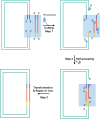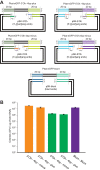T5 exonuclease-dependent assembly offers a low-cost method for efficient cloning and site-directed mutagenesis
- PMID: 30462336
- PMCID: PMC6379645
- DOI: 10.1093/nar/gky1169
T5 exonuclease-dependent assembly offers a low-cost method for efficient cloning and site-directed mutagenesis
Abstract
The assembly of DNA fragments with homologous arms is becoming popular in routine cloning. For an in vitro assembly reaction, a DNA polymerase is often used either alone for its 3'-5' exonuclease activity or together with a 5'-3' exonuclease for its DNA polymerase activity. Here, we present a 'T5 exonuclease DNA assembly' (TEDA) method that only uses a 5'-3' exonuclease. DNA fragments with short homologous ends were treated by T5 exonuclease and then transformed into Escherichia coli to produce clone colonies. The cloning efficiency was similar to that of the commercial In-Fusion method employing a proprietary DNA polymerase, but higher than that of the Gibson method utilizing T5 exonuclease, Phusion DNA polymerase, and DNA ligase. It also assembled multiple DNA fragments and did simultaneous site-directed mutagenesis at multiple sites. The reaction mixture was simple, and each reaction used 0.04 U of T5 exonuclease that cost 0.25 US cents. The simplicity, cost effectiveness, and cloning efficiency should promote its routine use, especially for labs with a budget constraint. TEDA may trigger further development of DNA assembly methods that employ single exonucleases.
© The Author(s) 2018. Published by Oxford University Press on behalf of Nucleic Acids Research.
Figures






Similar articles
-
CT5, a subtle in vitro DNA assembling method based on the combination of FnCas12a and T5 exonuclease.Biotechnol Lett. 2021 Apr;43(4):899-907. doi: 10.1007/s10529-020-03064-z. Epub 2021 Jan 3. Biotechnol Lett. 2021. PMID: 33389273
-
A simple and efficient seamless DNA cloning method using SLiCE from Escherichia coli laboratory strains and its application to SLiP site-directed mutagenesis.BMC Biotechnol. 2015 Jun 3;15:47. doi: 10.1186/s12896-015-0162-8. BMC Biotechnol. 2015. PMID: 26037246 Free PMC article.
-
Seamless Insert-Plasmid Assembly at High Efficiency and Low Cost.PLoS One. 2016 Apr 13;11(4):e0153158. doi: 10.1371/journal.pone.0153158. eCollection 2016. PLoS One. 2016. PMID: 27073895 Free PMC article.
-
Ordered deletions using exonuclease III.Methods Mol Biol. 1996;57:139-47. doi: 10.1385/0-89603-332-5:139. Methods Mol Biol. 1996. PMID: 8850001 Review. No abstract available.
-
Ordered deletions using exonuclease III.Methods Mol Biol. 1994;31:47-55. doi: 10.1385/0-89603-258-2:47. Methods Mol Biol. 1994. PMID: 7921037 Review. No abstract available.
Cited by
-
The cwp66 Gene Affects Cell Adhesion, Stress Tolerance, and Antibiotic Resistance in Clostridioides difficile.Microbiol Spectr. 2022 Apr 27;10(2):e0270421. doi: 10.1128/spectrum.02704-21. Epub 2022 Mar 31. Microbiol Spectr. 2022. PMID: 35357205 Free PMC article.
-
A mobile genetic element-derived primase-polymerase harbors multiple activities implicated in DNA replication and repair.Nucleic Acids Res. 2025 Jan 11;53(2):gkae1318. doi: 10.1093/nar/gkae1318. Nucleic Acids Res. 2025. PMID: 39797730 Free PMC article.
-
Structure-guided product determination of the bacterial type II diterpene synthase Tpn2.Commun Chem. 2022 Nov 8;5(1):146. doi: 10.1038/s42004-022-00765-6. Commun Chem. 2022. PMID: 36698006 Free PMC article.
-
Engineering sulfonate group donor regeneration systems to boost biosynthesis of sulfated compounds.Nat Commun. 2023 Nov 10;14(1):7297. doi: 10.1038/s41467-023-43195-1. Nat Commun. 2023. PMID: 37949843 Free PMC article.
-
TP73-AS1 is induced by YY1 during TMZ treatment and highly expressed in the aging brain.Aging (Albany NY). 2021 Jun 11;13(11):14843-14861. doi: 10.18632/aging.203182. Epub 2021 Jun 11. Aging (Albany NY). 2021. PMID: 34115613 Free PMC article.
References
-
- Ellis T., Adie T., Baldwin G.S.. DNA assembly for synthetic biology: from parts to pathways and beyond. Integr. Biol. 2011; 3:109–118. - PubMed
-
- Casini A., Storch M., Baldwin G.S., Ellis T.. Bricks and blueprints: methods and standards for DNA assembly. Nat. Rev. Mol. Cell Biol. 2015; 16:568–576. - PubMed
-
- Fu J., Bian X., Hu S., Wang H., Huang F., Seibert P.M., Plaza A., Xia L., Müller R., Stewart A.F.. Full-length RecE enhances linear-linear homologous recombination and facilitates direct cloning for bioprospecting. Nat. Biotechnol. 2012; 30:440. - PubMed
Publication types
MeSH terms
Substances
LinkOut - more resources
Full Text Sources

